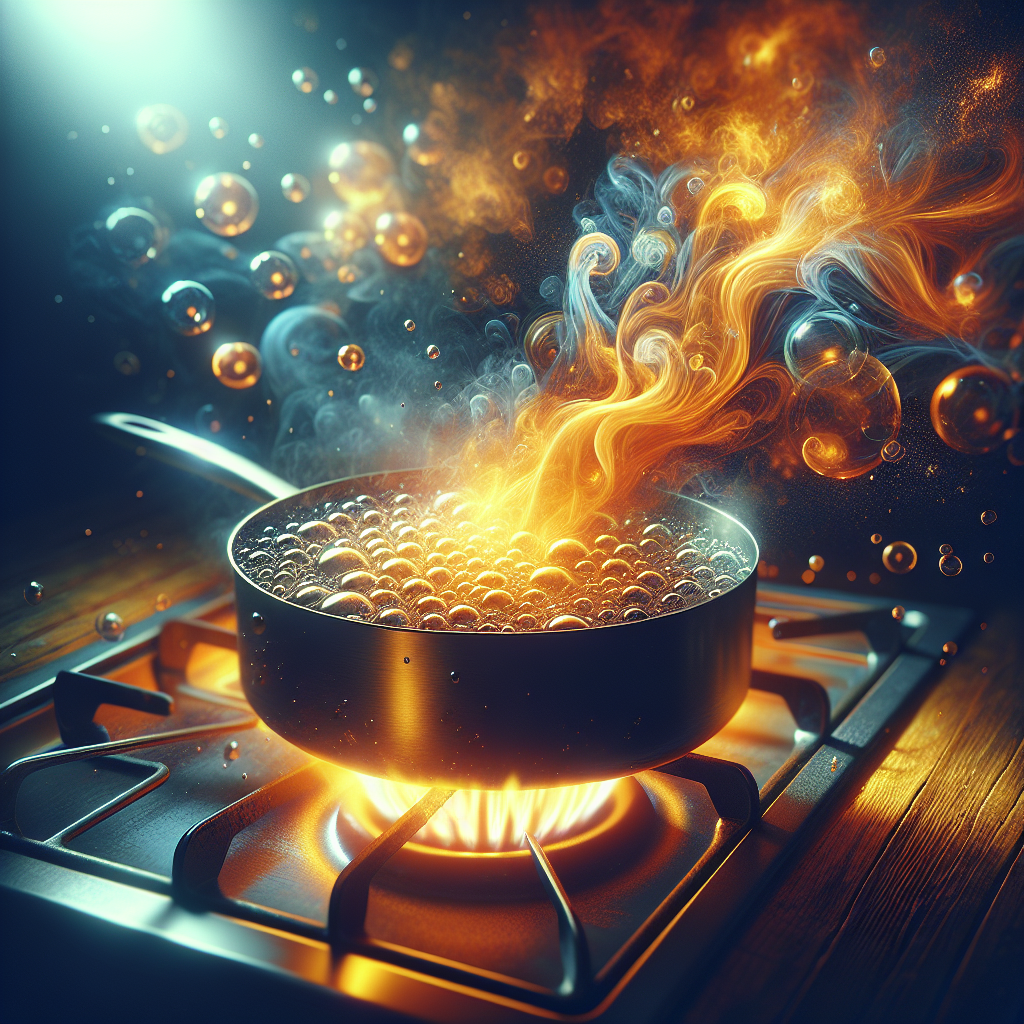In the world of cooking, there is a fascinating science behind the art of reduction. It’s a technique that allows you to intensify flavors, creating a depth and richness that can elevate any dish to new heights. Imagine taking a simple broth and transforming it into a velvety, flavorful sauce. Or turning a watery tomato soup into a thick, mouthwatering bisque. The process of reduction involves simmering liquids over heat, allowing them to evaporate and concentrate, resulting in a condensed, flavorful essence. Join us as we uncover the secrets of this culinary technique and unlock the potential to create unforgettable dishes in your own kitchen.

The Science of Reduction: Concentrating Flavors
Cooking is not only about combining ingredients and following recipes; it’s also about understanding the science behind the techniques used in the kitchen. One fundamental technique that every chef should master is reduction. Whether you are a seasoned cook or a beginner, understanding the science of reduction and how it concentrates flavors can take your dishes to the next level. In this article, we will explore the concept of reduction, its importance in cooking, how it works, and various techniques and factors that affect flavor concentration.
What is reduction?
Reduction, in culinary terms, refers to the process of evaporating the liquid in a dish to create a thicker and more concentrated flavor. It involves simmering or boiling a liquid, such as stocks, broths, or sauces, to evaporate the water content, leaving behind a more intense taste. Reduction not only enhances the flavors of the dish but also changes its texture, making it thicker and more enjoyable to eat.
Why is reduction important in cooking?
Reduction plays a crucial role in cooking as it enhances and intensifies the flavors of different ingredients. By reducing the liquid, the water content evaporates, leaving behind the essence and concentration of the other components in the dish. This process can transform a good dish into a remarkable one, by bringing out the underlying flavors and creating a depth of taste that can’t be achieved through other cooking methods.
How does reduction work?
Reduction works by increasing the concentration of flavors through the removal of water. As the liquid is heated and simmered or boiled, the water molecules start to evaporate, leaving behind a more condensed and rich flavor. This process allows the other components in the dish, such as herbs, spices, and aromatics, to become more prominent. The longer the reduction process, the more intense the flavors become.
The role of heat in reduction
Heat is a crucial factor when it comes to reduction. By applying heat to the liquid, the water molecules gain enough energy to break away from the liquid and turn into vapor. The higher the heat, the faster the evaporation process. However, it is important to balance the heat to prevent scorching or burning the ingredients in the dish. Heat provides the energy needed for the reduction process, but it should be monitored and adjusted accordingly to achieve the desired result.
Types of reduction techniques
There are several techniques to achieve reduction, each with its own purpose and application. Let’s explore some of the most common ones:
Evaporation
Evaporation, as the name suggests, involves the gradual reduction of liquid by letting it simmer over low heat for an extended period. This technique is commonly used for simmering stocks and broths to concentrate their flavors and create a rich base for soups, stews, and sauces. While time-consuming, evaporation allows the flavors to fully develop and intensify.
Simmering
Simmering is the process of gently boiling a liquid. It is often used to reduce sauces, gravies, and other liquid-based dishes. Simmering allows for a controlled reduction, where the liquid slowly evaporates and concentrates, without the risk of scorching or burning the ingredients. This technique is ideal for delicate flavors that require a longer cooking time for the best results.
Boiling
Boiling is a more rapid reduction technique where the liquid is brought to a vigorous boil. This method is commonly used when a quick reduction is required, such as reducing the sauce for a last-minute dish. Boiling can reduce the cooking time significantly, but it should be monitored closely to avoid overcooking or losing the delicate flavors.
Glazing
Glazing involves coating ingredients, such as vegetables or meats, with a reduced liquid or sauce to enhance their flavor and add a glossy finish. This technique is often used for caramelization, where the sugars in the glaze create a sweet and savory coating. Glazing can transform simple ingredients into a standout dish that is visually appealing and bursting with flavor.
Fond creation
Fond creation refers to the process of developing a rich brown crust or coating at the bottom of a pan when searing meat or vegetables. This fond is then deglazed, using a liquid like wine or broth, to create a flavorful base for sauces or gravies. Fond creation not only adds depth of flavor but also utilizes the concentrated flavors stuck to the pan, ensuring no flavor goes to waste.
Flavor Concentration and Chemical Reactions
To understand the impact of reduction on flavors, we must delve into the world of flavor compounds and the chemical reactions that occur during the reduction process.
Understanding flavor compounds
Flavor compounds are complex molecules that give ingredients their unique taste and aroma. These compounds interact with our taste buds and olfactory receptors to create the perception of flavor. Different ingredients have their own set of flavor compounds, which can be enhanced and concentrated through reduction. By understanding the flavor compounds present in the ingredients, chefs can effectively manipulate and intensify the taste of their dishes.
Chemical reactions during reduction
Reduction involves more than just evaporation; it also triggers chemical reactions that add depth and complexity to the flavors. Two common chemical reactions that occur during reduction are the Maillard reaction and caramelization.
Maillard reaction
The Maillard reaction is a chemical reaction between amino acids and reducing sugars that results in browning and the creation of complex flavors and aromas. This reaction occurs when proteins and sugars are subjected to high heat during the reduction process. The Maillard reaction is responsible for the rich, savory, and roasted flavors found in foods like seared meats, caramelized onions, and toasted bread.
Caramelization
Caramelization is the process of heating sugars until they break down and turn into a syrupy brown liquid. This reaction occurs when the sugars in the ingredients are exposed to heat, causing them to caramelize and develop a rich, sweet flavor and golden color. Caramelization adds depth and complexity to dishes, such as desserts, sauces, and glazes, by creating a unique balance of sweetness and bitterness.
Deglazing for flavor enhancement
Deglazing is the technique of using liquid to loosen and dissolve the flavorful bits stuck to the bottom of a pan after cooking. This technique is commonly used after fond creation to extract the concentrated flavors and create a rich base for sauces or gravies. By deglazing, chefs can capture the full essence of the ingredients, elevating the taste and texture of the dish.
Factors Affecting Flavor Concentration
Several factors can influence the degree of flavor concentration achieved through reduction. Understanding and manipulating these factors can help chefs optimize their dishes’ taste and texture.
Ingredient selection
The choice of ingredients can greatly impact the flavor concentration. Ingredients with stronger natural flavors, such as herbs, spices, and aromatics, can enhance the overall taste when reduced. Additionally, the quality and freshness of the ingredients play a significant role in achieving optimal results.
Cooking time
The duration of the reduction process directly affects the flavor concentration. Longer cooking times allow for a more thorough evaporation, resulting in a more intense and concentrated taste. However, it is essential to monitor the dish closely to prevent burning or overcooking.
Cooking temperature
Cooking temperature determines the rate of evaporation, affecting the speed and intensity of the reduction. Lower temperatures allow for a slower reduction, allowing flavors to develop more gradually. Higher temperatures can accelerate the process but require careful attention to prevent scorching or burning.
Amount of liquid used
The amount of liquid used in a recipe impacts the flavor concentration achieved through reduction. Less liquid means a smaller volume to evaporate, resulting in a more concentrated flavor. On the other hand, using too little liquid can lead to a lack of moisture and potentially burn the ingredients.
Rate of evaporation
The rate of evaporation determines how quickly the water content is removed, affecting the intensity of flavors. A faster evaporation rate can result in a more concentrated taste, but it requires close monitoring to prevent burning or overreduction.
Enhancing Flavor with Reduction
Reduction is a versatile technique that can be used in various culinary applications to enhance flavors and elevate dishes to new heights.
Concentrated stocks and broths
By reducing stocks and broths, chefs can create a more intense and flavorful base for soups, stews, and sauces. The concentrated flavors add depth and richness that can’t be achieved through simply using the original liquid. Whether it’s a classic chicken stock or a vegetable broth, reduction can transform them into culinary masterpieces.
Sauces and gravies
Sauces and gravies often benefit from reduction, as it allows the flavors to concentrate and develop. Whether it’s a savory pan sauce or a luxurious reduction for a steak, reducing the sauce intensifies the taste, creating a truly memorable accompaniment to the main dish.
Reduction in desserts and sweets
Reduction is not limited to savory dishes; it can also be used in desserts and sweet dishes. By reducing fruit juices or syrups, chefs can concentrate the natural sweetness and flavors, creating a delectable sauce or glaze. Reduction can turn a simple fruit compote into a luscious dessert topping or transform a plain syrup into a flavorful addition to cakes and pastries.
The use of reduction in beverages
Reduction is not exclusive to food; it can also be utilized in beverages to enhance flavors. Whether it’s a reduction of wine for a robust sauce, a reduction of fruit juice for a refreshing cocktail, or a reduction of coffee for a concentrated shot of espresso, reduction can elevate the taste and complexity of various beverages, turning them into true culinary delights.
Tips and Techniques for Effective Reduction
To achieve the best results when using reduction techniques, it is essential to follow these tips and techniques:
Choosing the right pot
Selecting the right pot is crucial for effective reduction. A pot with a wide bottom provides more surface area for evaporation, allowing for faster reduction. Non-reactive materials, such as stainless steel or enameled cast iron, are ideal for reduction as they do not react with the ingredients and alter the flavor.
Using the proper heat
Maintaining the correct heat throughout the reduction process is key. Start with higher heat to bring the liquid to a simmer or boil, and then reduce the heat to maintain a gentle simmer. Adjust the heat as needed to prevent scorching or burning.
Monitoring the reduction process
Keep a close eye on the reduction process to prevent overreduction or burning. Stir the liquid occasionally to ensure even evaporation and to prevent any buildup or scorching at the bottom of the pot.
Balancing flavors
As the reduction process intensifies flavors, it is crucial to balance the taste by adjusting seasonings and other flavor components. Taste the dish periodically and make any necessary adjustments to ensure a harmonious and well-rounded flavor profile.
Storage and use of reduced ingredients
Once the reduction process is complete, it is important to store and use the reduced ingredients properly. They can be refrigerated for a few days or frozen for longer periods. The concentrated flavors can be used as a base for future dishes or added to existing recipes to enhance the taste.

Conclusion
The science of reduction is a fascinating concept that allows chefs to concentrate flavors, elevate dishes, and create culinary masterpieces. By understanding the principles behind reduction, the chemical reactions involved, and the factors that affect flavor concentration, any cook can become a flavor magician in the kitchen. Experiment with different techniques, ingredients, and temperatures to find the perfect balance and create dishes that will leave your taste buds ecstatic. So next time you’re in the kitchen, remember the magic of reduction and let the flavors take center stage.


